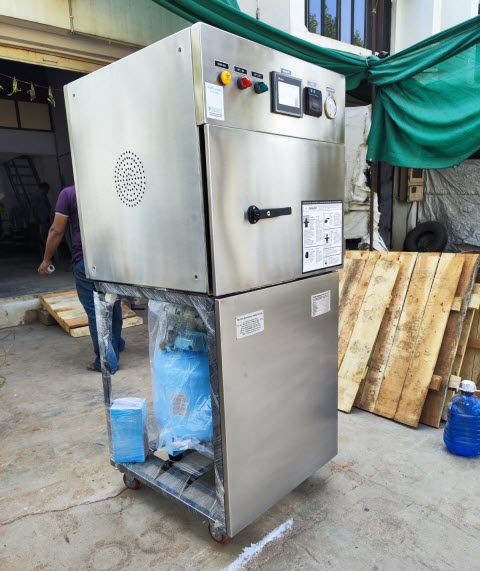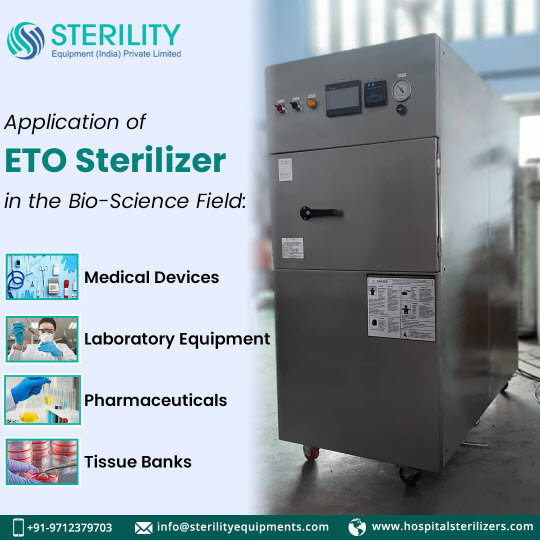ETO sterilizers, an integral part of the medical industry, play a critical role in maintaining the sterility of medical instruments by eliminating harmful microorganisms. Understanding and adhering to the safety standards that govern these sterilizers are of utmost importance in upholding the integrity of healthcare processes. In the United States, regulatory bodies have implemented rigorous safety guidelines, which manufacturers and healthcare facilities must strictly follow. These standards ensure the highest level of safety for both healthcare workers and patients, preventing the risk of infections and upholding the quality of patient care.
Importance of Adhering to ETO Sterilizer Safety Guidelines
Adhering to ETO sterilizer safety guidelines is of paramount importance for healthcare settings as it directly impacts the safety and well-being of both healthcare workers and patients. These guidelines are meticulously designed to ensure that all medical instruments and equipment undergo proper sterilization, leaving no room for harmful microorganisms to thrive.
- Patient Safety: The primary goal of healthcare facilities is to provide safe and effective care to patients. By strictly following ETO sterilizer safety guidelines, medical facilities can significantly reduce the risk of infections caused by contaminated instruments. Infection prevention is critical, particularly for vulnerable patients, such as those undergoing surgeries, immunocompromised individuals, and newborns. Adherence to safety guidelines ensures that patients are protected from potential complications and health risks associated with inadequately sterilized equipment.
- Healthcare Worker Protection: Healthcare workers are at the frontlines of patient care and are directly exposed to medical instruments. Adherence to safety guidelines protects healthcare workers from exposure to harmful pathogens like bacteria, viruses, and other microorganisms that may be present on improperly sterilized equipment. This safeguarding of healthcare workers is not only essential for their well-being but also for the overall functioning of healthcare facilities. When healthcare workers feel safe and secure in their work environment, it fosters a positive atmosphere and enhances their dedication to providing quality care.
- Preventing Healthcare-Associated Infections (HAIs): HAIs are a significant concern in healthcare settings. Infections acquired during hospital stays can lead to prolonged recovery periods, increased healthcare costs, and in severe cases, even mortality. Adherence to ETO sterilizer safety guidelines is an effective measure to prevent HAIs, as it ensures that all instruments used in patient care are thoroughly sterilized and free from pathogens. This proactive approach can significantly reduce the incidence of HAIs, benefitting both patients and healthcare facilities.
- Maintaining Quality Patient Care: Properly sterilized medical equipment is a cornerstone of quality patient care. When instruments are free from contamination, medical procedures can be performed with confidence, and the risk of complications is minimized. High-quality patient care is essential for positive treatment outcomes and patient satisfaction. Adhering to safety guidelines reflects a commitment to excellence in healthcare services and promotes patient trust in the facility’s capabilities.
- Legal and Regulatory Compliance: Regulatory bodies in the USA establish stringent safety guidelines to ensure uniformity and adherence to best practices in sterilization. Medical facilities must comply with these regulations to maintain their licenses and certifications. Failure to adhere to safety guidelines can result in legal consequences, fines, and damage to the facility’s reputation. On the other hand, demonstrating compliance enhances the facility’s credibility and trustworthiness among patients, staff, and stakeholders.
- Creating a Safe Working Environment: Healthcare workers deserve a safe and secure working environment where they can focus on providing exceptional care to patients. Adhering to ETO sterilizer safety guidelines fosters a culture of safety within the facility, where all staff members are actively involved in maintaining high standards of hygiene and infection control. This collective effort creates a supportive and productive workplace, benefiting everyone involved in the healthcare process.

Key Safety Features in Modern ETO Sterilizers
Modern ETO sterilizers are at the forefront of infection control, boasting cutting-edge safety features that ensure the highest level of sterilization effectiveness and reliability. Embracing the latest technological advancements, these sterilizers offer a range of key safety features that play a crucial role in safeguarding healthcare workers and patients.
- Advanced Monitoring Systems: Modern ETO sterilizers are equipped with sophisticated monitoring systems that constantly oversee the sterilization process. These systems ensure precise control and regulation of sterilization parameters, such as temperature, humidity, and exposure time. Real-time monitoring allows for immediate adjustments, optimizing sterilization efficacy and preventing deviations that could compromise the process.
- Automated Safety Interlocks: Safety interlocks are a vital component of modern ETO sterilizers. These automated mechanisms prevent the door from being opened until the sterilization process is complete and it’s safe to do so. This feature minimizes the risk of accidental exposure to ethylene oxide gas, protecting both operators and other individuals in the vicinity from potential hazards.
- Intricate Ventilation Systems: ETO sterilizers are designed with sophisticated ventilation systems that ensure the safe removal of residual ethylene oxide after the sterilization process. Effective ventilation prevents the accumulation of harmful gases, maintaining a safe working environment for healthcare workers and reducing the risk of exposure.
- Fault Detection and Alarms: To enhance safety, modern ETO sterilizers are equipped with fault detection systems that promptly identify any abnormalities or malfunctions during the sterilization process. When a fault is detected, alarms are triggered, alerting operators to the issue, and ensuring immediate attention and resolution.
Ensuring Operator Safety during ETO Sterilization
Operators play a crucial and indispensable role in the ETO sterilization process, and their safety is a top priority for healthcare facilities.
- Personal Protective Equipment (PPE): Providing operators with appropriate personal protective equipment is the first line of defense against potential hazards during ETO sterilization. This includes wearing nitrile or neoprene gloves to prevent skin contact with ethylene oxide, masks to protect against inhalation of the gas, and goggles to shield the eyes from splashes or emissions.
- Safe Handling and Storage of Ethylene Oxide: Operators must be well-informed about the safe handling and storage of ethylene oxide. This includes understanding the properties of the gas, potential hazards, and proper procedures for its transportation and storage to minimize risks and ensure safe usage.
- Ventilation and Engineering Controls: Adequate ventilation and engineering controls are essential to maintain a safe working environment during ETO sterilization. Properly designed ventilation systems ensure the timely removal of ethylene oxide gas from the workspace, reducing the risk of exposure to hazardous levels.

Safeguarding Patients through ETO Sterilization
ETO sterilization plays a vital role in safeguarding patients from infections in medical settings. By adhering to stringent safety guidelines, medical facilities can ensure that surgical instruments and equipment used during medical procedures are free from harmful pathogens, reducing the risk of potential complications for patients. This essential process significantly contributes to the prevention of hospital-acquired infections (HAIs) and upholds the highest standard of patient care.
- Effective Elimination of Pathogens: ETO sterilization is highly effective in eliminating various microorganisms, including bacteria, viruses, and spores, from medical equipment. This thorough sterilization process ensures that instruments used in surgeries and other medical procedures are free from harmful pathogens, minimizing the risk of post-operative infections and complications.
- Preventing Healthcare-Associated Infections (HAIs): HAIs are a significant concern in healthcare settings, causing considerable morbidity and mortality. By implementing robust ETO sterilization practices, medical facilities can reduce the incidence of HAIs and protect vulnerable patients from infections acquired during their hospital stays. This preventive approach contributes to improved patient outcomes and shorter recovery times.
- Enhancing Patient Safety and Confidence: Knowing that medical instruments have undergone proper sterilization using ETO provides patients with a sense of safety and confidence in the healthcare facility. Patient trust is a crucial aspect of healthcare, and ensuring the highest standards of sterilization reinforces the facility’s commitment to patient safety and well-being.
- Minimizing Cross-Contamination Risks: Cross-contamination is a serious concern in medical settings, where patients may have different levels of immune resistance. ETO sterilization ensures that reusable medical equipment is free from pathogens after each use, reducing the risk of transferring infections between patients.
- Supporting Surgical Success: Properly sterilized instruments play a pivotal role in the success of surgical procedures. Contaminated instruments can compromise surgical outcomes and lead to post-operative complications. ETO sterilization provides a reliable barrier against infections, enabling surgeons to focus on the procedure with confidence.
Maintenance and Validation of ETO Sterilizers
Ensuring the optimal performance and safety of ETO sterilizers is vital for healthcare facilities to maintain a high standard of sterilization efficacy. Regular maintenance and validation procedures are essential components of this process, providing several key benefits:
- Guaranteeing Equipment Performance: Regular maintenance of ETO sterilizers ensures that all components are in proper working condition. By conducting routine inspections and preventive maintenance, potential issues can be identified and addressed before they escalate into larger problems. This proactive approach guarantees that the sterilizer operates at its peak performance, consistently delivering reliable sterilization results.
- Meeting Safety Standards and Regulations: Validation procedures play a crucial role in ensuring that ETO sterilizers meet all required safety standards and regulatory guidelines. Periodic equipment validation confirms that the sterilization process adheres to the specified parameters and that the equipment remains within the approved performance limits. This compliance is essential for maintaining the trust of regulatory bodies and ensuring the safety of healthcare workers and patients.
- Minimizing Downtime and Disruptions: Regular maintenance and validation help prevent unexpected breakdowns and equipment malfunctions. By identifying potential issues early on, healthcare facilities can schedule necessary repairs and maintenance during planned downtimes, minimizing disruptions to the sterilization process. This approach ensures that the facility can consistently provide sterile instruments for medical procedures without delays.
- Extending Equipment Lifespan: ETO sterilizers are significant investments for healthcare facilities. Regular maintenance and validation can extend the equipment’s lifespan, optimizing the return on investment. Properly maintained sterilizers are less likely to experience premature wear and tear, reducing the need for frequent replacements.
- Enhancing Infection Control: The reliability of ETO sterilizers is crucial for infection control in healthcare settings. Regular maintenance and validation contribute to consistent and effective sterilization, minimizing the risk of healthcare-associated infections (HAIs) caused by contaminated instruments. This supports the overall infection control efforts of the facility and ensures the safety of patients and healthcare workers.





